I want to make sure this point is well understood: it is a rare opportunity to have the top researchers in a topic be present and answer your questions/provide clarifications. Please be on your best behavior. Anything less is not acceptable.
-
Welcome to ASR. There are many reviews of audio hardware and expert members to help answer your questions. Click here to have your audio equipment measured for free!
You are using an out of date browser. It may not display this or other websites correctly.
You should upgrade or use an alternative browser.
You should upgrade or use an alternative browser.
I cannot trust the Harman speaker preference score
- Thread starter sarumbear
- Start date
Holmz
Major Contributor
…
On the face of it, the rating does not look like a major tool that I can use in my quest for better speakers for my 2 speakers stereo home music reproduction system.
I used it
Except that it isn't. A speaker with score of 6 tells you a lot about its fidelity.
….
And a rating of 7 also tells us something more than a 6
ferrellms
Senior Member
- Joined
- Mar 24, 2019
- Messages
- 363
- Likes
- 312
Check the patent below.The more I look into it the less I can trust the Harman speaker quality score. IMHO it is a totally meaningless metric. I know the background, I read all the papers even before Harman was involved, and their patent. However, it works so badly that IMHO it is a meaningless metric.
Here are some scores that I took from this database to prove why.
The KEF Reference 2C Meta: 5.6
Sonos Roam: 5.5
JBL M2: 5.1
The 17cm x 6cm smart-speaker Sonos Roam scores just shy of a real reference of a speaker from KEF, while a JBL flagship that weighs 60kg scores less than that smart-speaker.
Do I have a case or not?
----
Edit: I copied below some more comparisons I posted later in the thread.
Revel Ultima2 Salon2: 6
Google Nest Audio: 5.5
Apple Homepod: 4.9
Bowers & Wilkins 803 D3: 4.8
1. Take a bunch of frequency response measurements, on and off-axis, of a speaker in an anechoic chamber (or with the Klippel which removes room effects). This creates the spinorama curves.
2. Have a listener panel rate listening quality after hearing the single speaker. Look for statistical correlations between the different spinorama curves and panel speaker ratings.
3. Repeat with lots of different speakers and panels.
Eventually you can conclude that certain spinorama curve characteristics correlate with listener speaker quality ratings and can come up with a number that predicts how the listening panels would rate the speaker. Bravo!
There is no claim in the patent that this is the end-all standard for speaker quality. It seems to me to be about as good as you can expect to get by measuring frequency responses of a single speaker, which are generally considered the most important variables determining audible "quality". This is not rocket science, but seems straightforward enough and very useful. But it is not all there is to say about the (personally subjective or objectively measurable) quality of the sound of a pair of speakers in a room playing music!
US20050195982A1 - Method for predicting loudspeaker preference - Google Patents
A general model is provided for predicting a loudspeaker preference rating, where the model's predicted loudspeaker preference rating is calculated based upon the sum of a plurality of weighted independent variables that statistically quantify amplitude deviations in a loudspeaker frequency...
patents.google.com
Last edited:
It's important to understand that the short comings I mentioned are not really related to room modes. And because the deviations are so high in frequency, multiple subwoofers wouldn't be a solution to remedy them, other than minimizing a dip around 150 Hz with "flanking" subwoofers (placed closed to the front) that are crossed in the 120-140 Hz area.Thank you for displaying these curves Bjorn. They look totally familiar, in that the predicted room curve is a good match above about 500 Hz, and is corrupted by room interactions at lower frequencies. All of this is discussed in AES papers dating from the mid 1980s, and my books. Obviously all setups and rooms yield different curves at lower frequencies, so individual attention is required for each installation if maximum performance is expected. Listeners have a powerful ability to adapt to, and “listen through” rooms to the extent that, in a given room, they are able to rate and rank the inherent sound quality of loudspeakers in a relative sense – the good ones still win, the bad ones still lose. However, in setting up one’s personal system the job is not done. To maximize the satisfaction from any loudspeaker, whatever its inherent performance, the huge influence of the room at lower frequencies must be addressed, and we know that bass is a substantial factor (30 %) in our perception of sound quality.
At frequencies below transition/Schroeder room resonances must be tamed, and if done successfully, the sound quality will improve, and it will be improved for multiple listeners, not just in the sweet spot. Multiple subwoofers in a bass managed system is the best solution. Bass management high-pass filters the satellite (bookshelf?) loudspeakers allowing them to play louder. This is inconvenient or impossible for dedicated two-channel listeners, but bass management is included in all multichannel processors. This alone might be motivation to have the option of occasional multichannel experiences or upmixing – 5.1 systems can be impressive; Atmos is overkill, but is commercially driven by you-know-who.
Notions that multichannel systems are incapable of superb two-channel reproduction are wrong. With bass management and competently designed subwoofer systems a system based on good bookshelf units can be seriously good. For me, video music concerts of all musical genres can provide high quality entertainment – there are many mediocre examples, unfortunately, but the best of them have excellent multichannel sound tracks putting you at the performance – and I like seeing the performers.
Still not at all as good as the live LA Phil concert we attended recently.
I have set up some rooms with multiple subwoofers. While it can yield a very even response, it doesn't work to address the time domain in the most sensitive bass region, it tends to sound a bit messy when some are placed in the rear compared to having all the subwoofers in the front, and the "slam" and "punch" is reduced when they're placed against each other (some in front and some in the back) unless they operate in different regions with a crossover. For me, the multiple subwoofer approach that are operating in the same frequencies is another mediocre way compared to better options.
Commercially, it would great to sell multiple subwoofers though. I have a subwoofer design I'm close to releasing.
Yes. The 100hz-and-up is the problem, and this is above the bass-system crossover. How the speaker performs here, entirely relates to its radiation, a more controlled pattern improves performance in time, and sometimes it can be clearly seen on the freq resp also. To really see what is going on, it is necessary to look at what happens in time, frequency alone does not tell the story. Then speaker placement also matters, and of course acoustic treatment can improve things dramatically.It's important to understand that the short comings I mentioned are not really related to room modes. And because the deviations are so high in frequency, multiple subwoofers wouldn't be a solution to remedy them, other than minimizing a dip around 150 Hz with "flanking" subwoofers (placed closed to the front) that are crossed in the 120-140 Hz area.
I have set up some rooms with multiple subwoofers. While it can yield a very even response, it doesn't work to address the time domain in the most sensitive bass region, it tends to sound a bit messy when some are placed in the rear compared to having all the subwoofers in the front, and the "slam" and "punch" is reduced when they're placed against each other (some in front and some in the back) unless they operate in different regions with a crossover. For me, the multiple subwoofer approach that are operating in the same frequencies is another mediocre way compared to better options.
Commercially, it would great to sell multiple subwoofers though. I have a subwoofer design I'm close to releasing.
Bass and multi-sub is another subject, and - not surprisingly - my experience is similar. Place all units up front, close to the main speakers, start with that, and then, if tactile feel is lacking or there are huge, wide dips, then you can try adding units at the back of the room. Those back units need the right eq and delay, if this is to work better than just 2 sub units up front. To make this work, requires some experience. And of course measurements. If you can't measure velocity/direction of the sound field, you also need to listen and know what to listen for. A bit more complex than simply eq to flat frequency response, but that does not mean it can not be done. Because it can.
The standard ANSI-CTA-2034 ... ?I know, but unfortunately many manufacturers ignore it.
Ja and no. From my perspective the ingenious trick is not to set that particular standard, but to oblige the two sides, namely producers of records and the manufacturers of replay gear to follow the same ideal.
Of course the choice for the parameter set tested by the procedures in the ANSI... is to a higher extent based on good reasoning and backed up by scientific experiments. But, frankly, similar requirements were around a long time before.
Anyway, quality manufacturers for both, studio and home gear seem to follow the 'new deal' more and more. I'm not a quality OEM, but even as an amateur in speaker building I love to see such well elaborated guidelines.
BoredErica
Addicted to Fun and Learning
Hi, I've always had a question in the back of my mind. My understanding is larger speakers tend to be more directional in bass frequencies, whereas smaller bookshelves tend to go omnidirectional earlier.Notions that multichannel systems are incapable of superb two-channel reproduction are wrong. With bass management and competently designed subwoofer systems a system based on good bookshelf units can be seriously good.
Example: Genelec 8314A
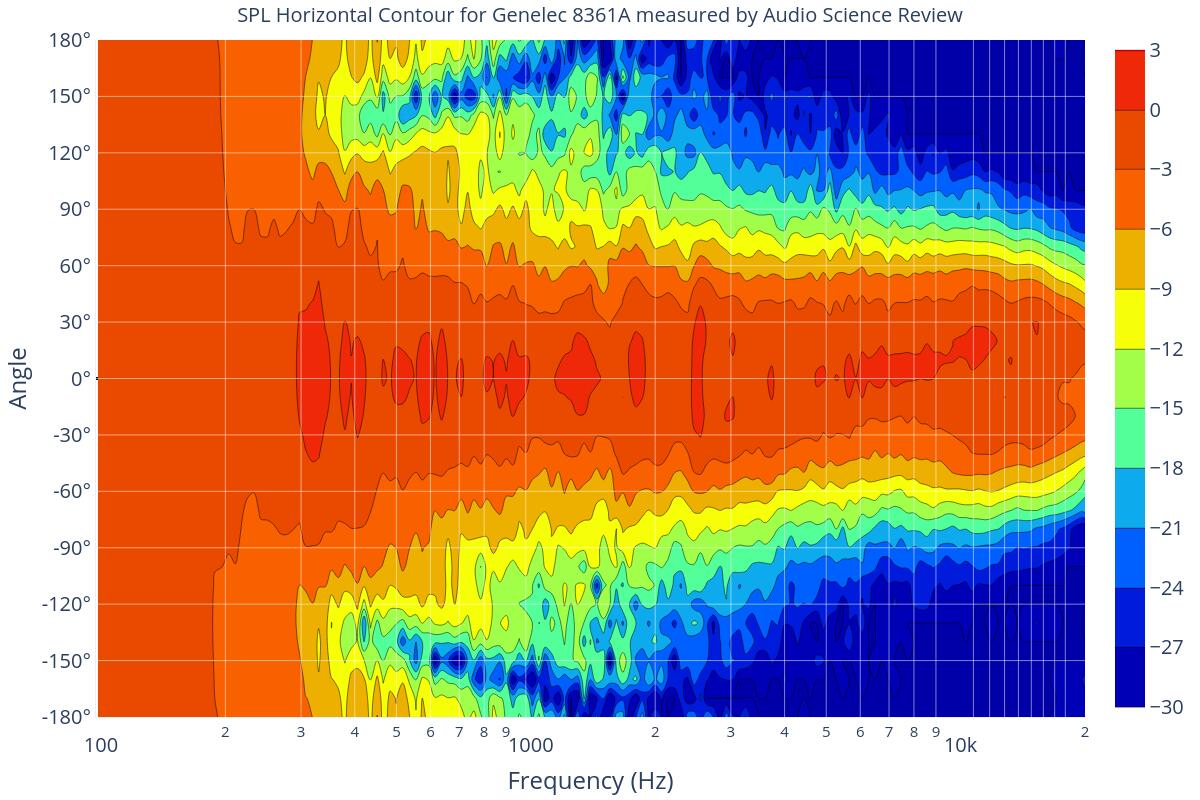

Thanks
TimVG
Major Contributor
- Joined
- Sep 16, 2019
- Messages
- 1,212
- Likes
- 2,713
Hi, I've always had a question in the back of my mind. My understanding is larger speakers tend to be more directional in bass frequencies, whereas smaller bookshelves tend to go omnidirectional earlier.
Example: Genelec 8314A
Genelec 8331A
Is there any research on whether going omnidirectional in the bass starting from a lower frequency is preferred or not? If not, do you have any opinions on this? It's one of the debates on forums... whether larger speakers sound bigger somehow, and some people point to this as the reason.
Thanks
The largest subjective effect should not come from the bass, which is the modal region of the room, but what happens in the lower midrange - that ~500 to 1000Hz octave. Many speakers already start to lose pattern control there. This means that the reflected sounds will have a different spectral balance when compared to the direct sound.
In our Directiva R2 project, which is an ongoing DIY project on this forum, this is one of the matters we're addressing. Making sure the loudspeaker maintains pattern control down the modal region (200-300Hz) of the average room. If we look at the measurements, one can see that the top module (which operates from 200Hz upwards, and is to be augmented with a bass module [not a subwoofer]) is exemplary in this regard. The sound remains directional down to the modal region, in which the bass module takes over and can be EQ'ed to taste.
Floyd Toole
Addicted to Fun and Learning
Audio Luminary
Technical Expert
Industry Insider
Forum Donor
You said: "For me, the multiple subwoofer approach that are operating in the same frequencies is another mediocre way compared to better options." It is for me too, and for Todd Welti and Allan Devantier who developed the Sound Field Management method of dealing with non-rectangular rooms. This employs separate digitally processed feeds to each sub. I have enjoyed it for about 20 years and it is a treat - the room is gone at low frequencies.It's important to understand that the short comings I mentioned are not really related to room modes. And because the deviations are so high in frequency, multiple subwoofers wouldn't be a solution to remedy them, other than minimizing a dip around 150 Hz with "flanking" subwoofers (placed closed to the front) that are crossed in the 120-140 Hz area.
I have set up some rooms with multiple subwoofers. While it can yield a very even response, it doesn't work to address the time domain in the most sensitive bass region, it tends to sound a bit messy when some are placed in the rear compared to having all the subwoofers in the front, and the "slam" and "punch" is reduced when they're placed against each other (some in front and some in the back) unless they operate in different regions with a crossover. For me, the multiple subwoofer approach that are operating in the same frequencies is another mediocre way compared to better options.
Commercially, it would great to sell multiple subwoofers though. I have a subwoofer design I'm close to releasing.
What happens between about 100 and 500 Hz is indeed messy, being a combination of adjacent boundary "radiated power" issues and acoustical interference. There is no perfect solution to that, but EQ definitely helps. Above 500 Hz detailed EQ is risky without anechoic data on the loudspeakers. Fortunately this seems to be something that humans can somewhat adapt to, as it happens in real life - even conversation.
Floyd Toole
Addicted to Fun and Learning
Audio Luminary
Technical Expert
Industry Insider
Forum Donor
Nice!The largest subjective effect should not come from the bass, which is the modal region of the room, but what happens in the lower midrange - that ~500 to 1000Hz octave. Many speakers already start to lose pattern control there. This means that the reflected sounds will have a different spectral balance when compared to the direct sound.
In our Directiva R2 project, which is an ongoing DIY project on this forum, this is one of the matters we're addressing. Making sure the loudspeaker maintains pattern control down the modal region (200-300Hz) of the average room. If we look at the measurements, one can see that the top module (which operates from 200Hz upwards, and is to be augmented with a bass module [not a subwoofer]) is exemplary in this regard. The sound remains directional down to the modal region, in which the bass module takes over and can be EQ'ed to taste.
View attachment 194591
View attachment 194592
I remember the low frequency response to be flat to around 200Hz in your previous measurements, is this the default unequalized cabinet tuning?The largest subjective effect should not come from the bass, which is the modal region of the room, but what happens in the lower midrange - that ~500 to 1000Hz octave. Many speakers already start to lose pattern control there. This means that the reflected sounds will have a different spectral balance when compared to the direct sound.
In our Directiva R2 project, which is an ongoing DIY project on this forum, this is one of the matters we're addressing. Making sure the loudspeaker maintains pattern control down the modal region (200-300Hz) of the average room. If we look at the measurements, one can see that the top module (which operates from 200Hz upwards, and is to be augmented with a bass module [not a subwoofer]) is exemplary in this regard. The sound remains directional down to the modal region, in which the bass module takes over and can be EQ'ed to taste.
View attachment 194591
View attachment 194592
TimVG
Major Contributor
- Joined
- Sep 16, 2019
- Messages
- 1,212
- Likes
- 2,713
No this is the filtered response, without the bass cabinet. Here's the transfer functionI remember the low frequency response to be flat to around 200Hz in your previous measurements, is this the default unequalized cabinet tuning?
What do you call “bass frequencies”? 100Hz has 3.4m wavelength and this cannot be directional.Hi, I've always had a question in the back of my mind. My understanding is larger speakers tend to be more directional in bass frequencies, whereas smaller bookshelves tend to go omnidirectional earlier.
If one wanted to control directivity down as low as possible, what would one look for? I see some suggestions that it might be related to the size of the drivers in some ways. Anecdotally, that is what I seem to find when I look at Genelec monitors. I did this because they have similar design goals and different size woofers which is the primary distinguishing factor. If you look at the light blue (-9dB) line you can see it moves from 1000 Hz to 500 Hz as you go from 5 ⅛" to 6 ½" to 8" to 10".
8330 (5.25")

8340 (6.5")
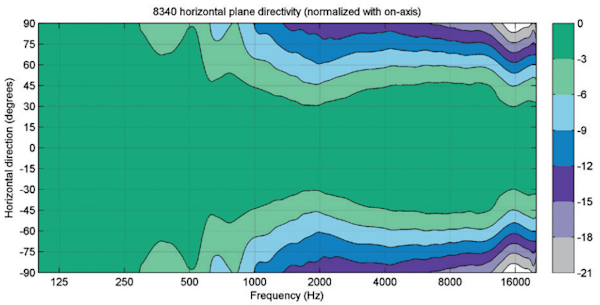
8350 (8")
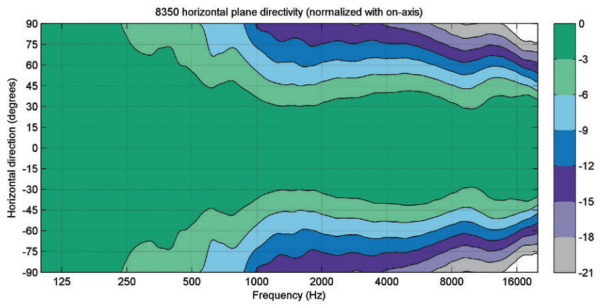
1032c (10") (different cabinet from the above and front-ported)

8330 (5.25")

8340 (6.5")

8350 (8")

1032c (10") (different cabinet from the above and front-ported)

dc655321
Major Contributor
- Joined
- Mar 4, 2018
- Messages
- 1,601
- Likes
- 2,272
If one wanted to control directivity down as low as possible, what would one look for? I see some suggestions that it might be related to the size of the drivers in some ways.
Look at the polar response, as you've shown. The ideal (unrealistic) shape would be like a searchlight beam. See figures 8 & 9 in attachment.
The size and shape of the cabinet can have a large impact on directivity too (assuming single driver, monopole design).
On multi-driver loudspeakers, the physical arrangement and geometry of drivers and xover design can also have dramatic impact.
I've found Geddes' paper on controlled directivity to be helpful (attached).
Attachments
I was just looking through some other speakers (not Dutch&Dutch or Kii), and there are few that seem to control directivity down to about 200 Hz. Given how hard the 200-500 Hz region is to manage, that is a potentially valuable attribute that (to stay on topic) doesn't show up in the "Olive score".
226Be from @hardisj looks particularly good
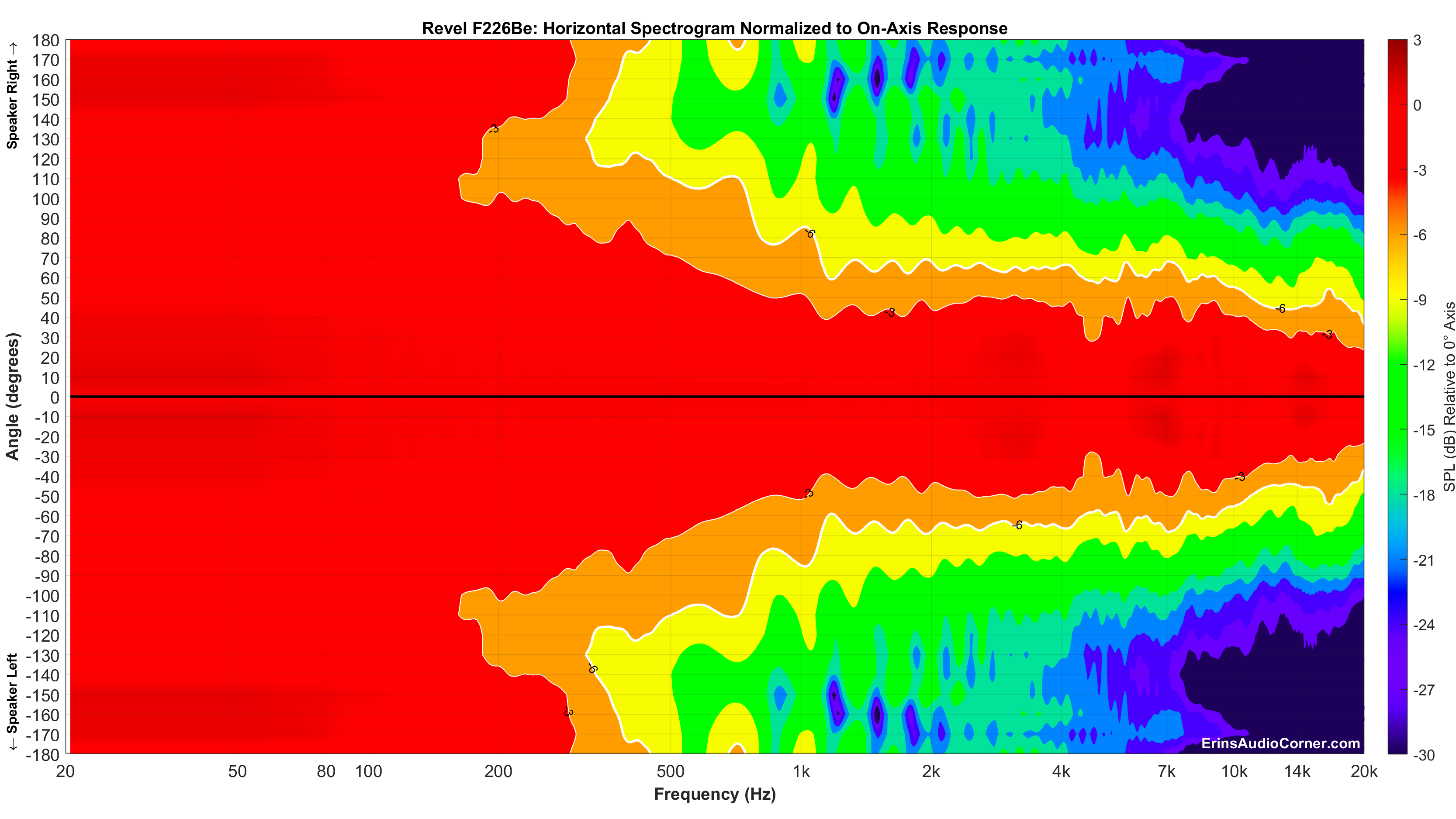
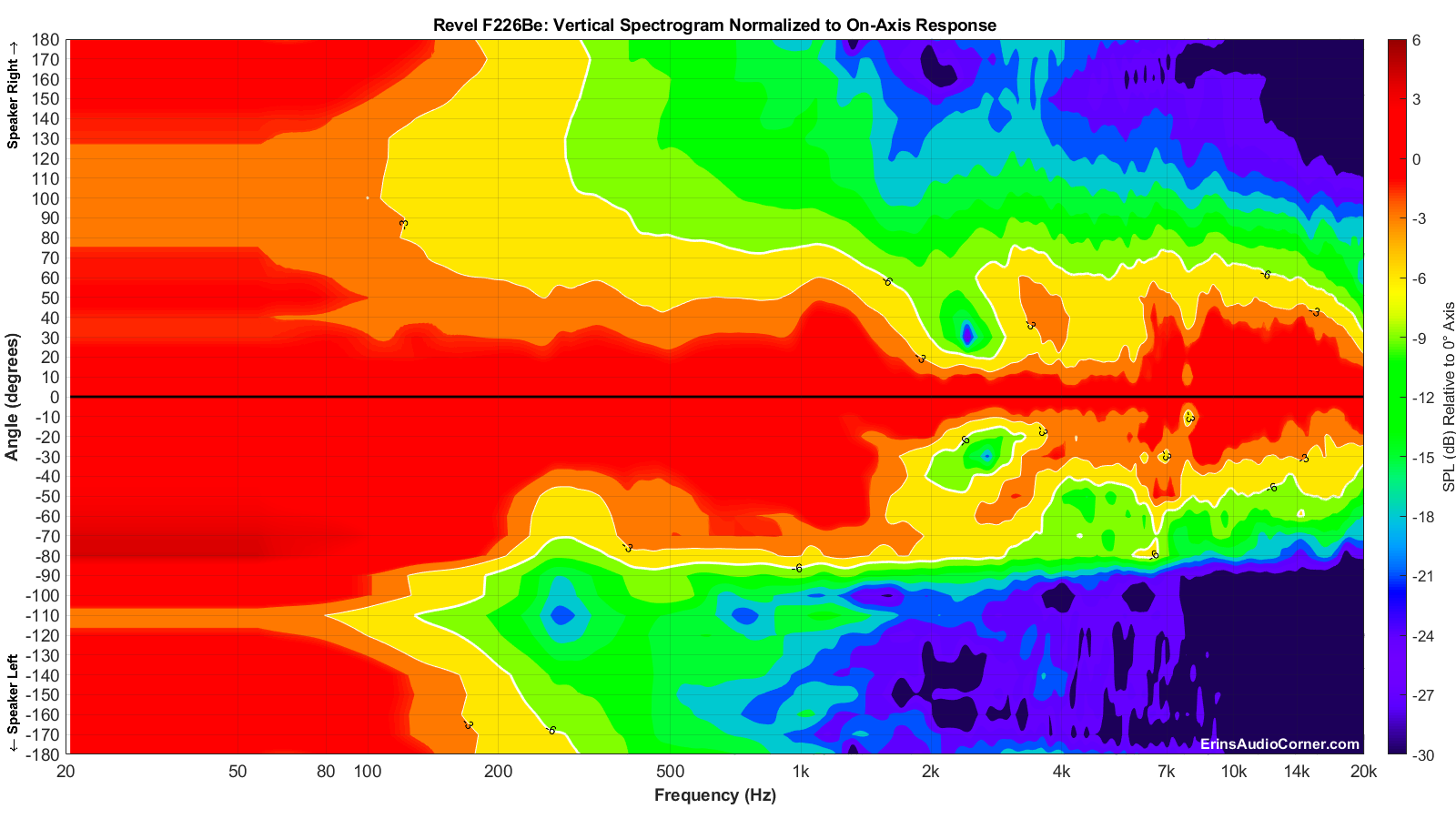
226Be from @hardisj looks particularly good


Last edited:
Looks great!The largest subjective effect should not come from the bass, which is the modal region of the room, but what happens in the lower midrange - that ~500 to 1000Hz octave. Many speakers already start to lose pattern control there. This means that the reflected sounds will have a different spectral balance when compared to the direct sound.
In our Directiva R2 project, which is an ongoing DIY project on this forum, this is one of the matters we're addressing. Making sure the loudspeaker maintains pattern control down the modal region (200-300Hz) of the average room. If we look at the measurements, one can see that the top module (which operates from 200Hz upwards, and is to be augmented with a bass module [not a subwoofer]) is exemplary in this regard. The sound remains directional down to the modal region, in which the bass module takes over and can be EQ'ed to taste.
View attachment 194591
View attachment 194592
Well, there is a solution, and it gives performance good enough that the behavior in 100-500 range will be similar to the rest of the spectrum.What happens between about 100 and 500 Hz is indeed messy, being a combination of adjacent boundary "radiated power" issues and acoustical interference. There is no perfect solution to that,
The speaker alone can improve things here, but can not alone achieve similar response across the full frequency range. Unfortunately. Still, some improvement can make a larger impact on the end result in a given room, and the speaker will not be so much affected by placement close to boundaries.
Presently42
Active Member
Forgiveness if this is a bit off topic, but might you elucidate this point a bit more? I thought I recalled @Floyd Toole writing, that eq only really affects the ON curve: if so, then one cannot use the DI to eq a speaker, as any attempt to do so will merely alter the ON curve, rather than the DI. Indeed, no curve at all can be used, other than the ON curve (though perhaps the ER curve can be useful: I've had great success, for example, using an amalgamation of the ON and ER curves - something I'd like to investigate more rigourously).A smooth DI cannot predict sound quality, but it can allow you to equalize Speaker B (Bad) to make it sound more like Speaker A.
There are much better speaker designs that flatten out this area and there's of course acoustical treatment. Both needed for a great result.What happens between about 100 and 500 Hz is indeed messy, being a combination of adjacent boundary "radiated power" issues and acoustical interference. There is no perfect solution to that, but EQ definitely helps. Above 500 Hz detailed EQ is risky without anechoic data on the loudspeakers. Fortunately this seems to be something that humans can somewhat adapt to, as it happens in real life - even conversation.
We are more sensitive to bass/low mid frequencies at 100-250 Hz than sub-frequencies, though we obviously want to have an excellent result for both ranges.
